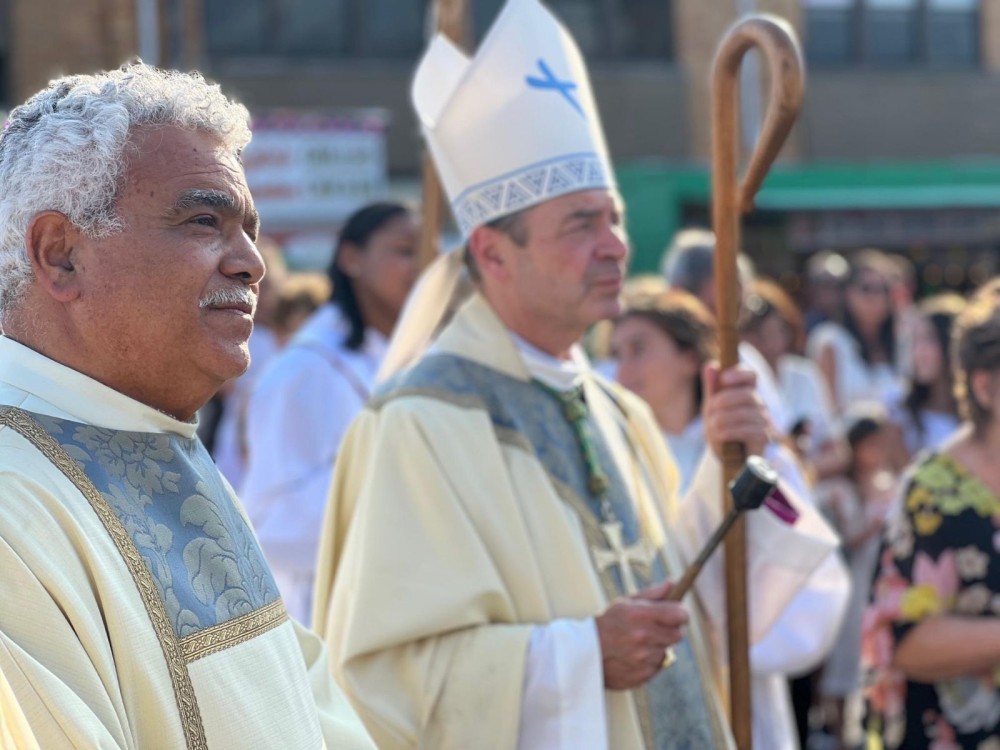
PROSPECT HEIGHTS — When it comes to diversity within the ranks of its diaconate, the Diocese of Brooklyn stands out.
Figures show that the makeup of the diocese’s permanent deacons is in sharp contrast to totals across the country. For instance — the number of Hispanic and black deacons is much higher than the national average.
In June, the United States Conference of Catholic Bishops (USCCB) Committee on Clergy, Consecrated Life and Vocations released the results of its annual survey on the diaconate.
The figures, compiled by the Center for Applied Research in the Apostolate (CARA), show that the vast majority — 73% — of deacons in the U.S. are white, 20% are Hispanic, and just 3% are African-American or black.
Out of the diocese’s 199 permanent deacons — 140 active and 59 retired — 46% are Hispanic (more than double the national average), and 10% are African-American/black, more than triple the national average. Additionally, 39% of the deacons are white, which is almost half the nationwide number.
Deacons serving in local churches throughout Brooklyn and Queens said they were not surprised, given the diocese’s reputation as the Diocese of Immigrants. Deacon Jorge Alvarado, who serves at Our Lady of Perpetual Help in South Ozone Park, is originally from Ecuador.
“I remember when I first came to my parish, there were only English Masses — no Spanish,” he said. “Then, Spanish-speaking people started coming to church and they started to get involved in prayer groups, serving as ushers and being part of other ministries. When the numbers went up, we started having a Spanish Mass.”
Given the increasing participation of Hispanics, it makes sense that it would eventually lead to higher numbers in the diaconate, according to Deacon Alvarado, who was ordained in 2009.
“We’re a mecca of people coming from all over the world,” said Deacon Ernest Hart, who was ordained in 2011 and serves at Christ the King-St. Mary Magdalene in Springfield Gardens.
“When you consider the number of languages that we speak in our diocese and in the city, it’s no surprise our numbers are high,” added Deacon Hart, whose parents came to the U.S. from the Caribbean. “It’s such a melting pot of different cultures and traditions. It doesn’t surprise me that we are different from the rest of the country.”
Permanent deacons are not to be confused with transitional deacons, who are men training for the priesthood and who serve as deacons for some time prior to their priestly ordination. Permanent deacons, on the other hand, are ordained to the role of deacon for life and often work secular jobs and are married with children.
Bishop Robert Brennan noted that the diversity in the ranks of deacons is one of the things that makes the diocese strong.
“It is awesome to see our deacons and candidates truly reflect our population here in Brooklyn and Queens,” he said. “This diversity makes it possible to minister to the pastoral needs of our Catholic communities throughout the diocese, united by our belief in the Lord.”
Deacon Julio Barreneche, secretary for clergy personnel, said the high number of minority deacons is partly due to the diocese’s concerted effort in recent years to have a diaconate that reflects the people in the pews.
“With the continuous growth of people of different ethnic groups in the Diocese of Brooklyn, the administration of our diocese has dedicated efforts to supply these groups with clergy that are not only fluent in the language the group speaks but also that know their cultures and customs,” he explained.
Those efforts include community outreach measures, religious education programs tailored to diverse communities, and targeted recruitment.
Deacon Jorge Castillo, a Guatemalan-American who was ordained in 2009 and serves at St. Joan of Arc in Jackson Heights, was recruited many years ago by his pastor at the time, Msgr. John McGuirl. “My wife Alma and I were very involved in the church. I was a lector and a Eucharistic Minister. One day, Msgr. McGuirl asked me if I would like to become a deacon,” he recalled.
When he confessed that he was unfamiliar with the responsibilities of a deacon, Msgr. McGuirl had an interesting answer.
“He told me, ‘You already do a lot of what a deacon does.’ So I started to think about it,” Deacon Castillo said. He added that he felt like “God was calling me, and he was using Msgr. McGuirl to do it.”
Deacons are vital to their parishes, not only because of their duties on the altar but because they often serve their communities in other ways, according to Bishop Brennan.
“I am very fortunate to have deacons who are so involved in the sacramental life of our parishes, as well as with the ministry of our apostolates, hospitals, and more,” he said.
Deacon Heriberto Cabrera, who was ordained last year and serves at St. Bernard of Clairvaux in Mill Basin, said the credit for the diversity in the diaconate goes to the man at the top, namely the bishop.
“It’s a wonderful thing. It reflects the diversity of our diocese. And frankly, it’s also a reflection of the bishops and how open they are in receiving,” he said. “I saw that with Bishop [Nicholas] DiMarzio, and I see it now with Bishop [Robert] Brennan. They have open arms, and they extend their arms constantly.”
Deacon Cabrera, who is originally from the Dominican Republic, added, “This is a diocese where people from different cultures feel at home.”

The County of Queens is the most diverse county in NYS, if not the country. So the Diocese of Brooklynnumbers mirror the demographic base of the region. Long term that should add to greater diocesean growth overall.